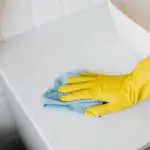You can remove nail polish from upholstery safely by first identifying your fabric type and testing an acetone-free nail polish remover on a hidden spot. Use a cotton ball to gently blot the stain, starting from the edge and avoiding rubbing to prevent damage. If acetone isn’t safe, try mild soap and water or natural remedies like vinegar. After blotting, let the fabric air dry. Keep exploring for more effective methods to restore your upholstery’s look.
Table of Contents
Key Takeaways
- Test an acetone-free nail polish remover on a hidden upholstery spot to check for color or texture changes before treatment.
- Use cotton balls or soft cloths dampened with remover, applying gently from the stain’s edges inward to avoid spreading.
- Blot the nail polish stain lightly without rubbing to lift polish without damaging fabric fibers.
- After stain removal, blot with a damp cloth to remove residue and allow the area to air dry completely.
- For delicate fabrics, consider mild dish soap solutions or professional cleaning to prevent damage.
Assessing the Type of Upholstery Fabric
Before you begin removing nail polish, you need to identify the type of upholstery fabric you’re dealing with. Different fabrics react differently to cleaning agents, so knowing what you’re working with helps prevent damage.
Check the manufacturer’s label, usually found under cushions or on the frame—it often lists fabric type and cleaning codes. If the label is missing, test a hidden area with a small amount of water or cleaner to see how it reacts.
Natural fabrics like cotton and linen absorb liquids quickly, while synthetics like polyester resist staining better. Delicate fabrics such as silk or velvet require extra caution.
Once you know the fabric, you can choose the safest method to remove nail polish without ruining your upholstery.
Gathering Essential Cleaning Supplies
To remove nail polish from your upholstery effectively, you’ll need a few essential cleaning supplies on hand.
Start by gathering cotton balls or soft white cloths, which won’t leave fibers behind. Have a gentle nail polish remover ready—preferably one labeled acetone-free to prevent fabric damage.
Gather cotton balls or soft cloths and use acetone-free nail polish remover to protect your upholstery.
You’ll also want mild dish soap and a bowl of warm water to help clean the area afterward. Keep a soft-bristled toothbrush or small sponge nearby for gentle scrubbing if needed.
Additionally, have paper towels or clean dry cloths to blot excess liquid and prevent spreading. Finally, keep a fan or hairdryer on hand to speed drying once the stain is treated.
With these supplies ready, you’ll be set to tackle the stain carefully and safely.
Testing Cleaning Solutions on a Hidden Area
Although it might seem like an extra step, testing your cleaning solution on a hidden area of the upholstery guarantees you won’t cause discoloration or damage.
Before applying any cleaner broadly, you want to make certain it’s safe for your fabric.
Follow these steps to test effectively:
- Choose a discreet spot, like under a cushion or behind a seam.
- Apply a small amount of the cleaning solution using a cotton swab.
- Wait 5-10 minutes to observe any changes in color, texture, or fabric integrity.
- If you notice no adverse effects, proceed with treating the stained area confidently.
This precaution helps protect your upholstery and assures a successful cleaning process.
Using Nail Polish Remover Safely on Upholstery
Before you apply nail polish remover, make sure you pick one that’s safe for your upholstery fabric.
Always test it on a hidden spot first to avoid any damage or discoloration.
Taking these steps helps protect your furniture while tackling the stain.
Choosing the Right Remover
Since different fabrics react uniquely to various chemicals, you’ll need to select a nail polish remover that’s both effective and safe for your upholstery.
Here’s what to take into account:
- Choose acetone-free removers – Acetone can damage delicate fabrics and strip colors.
- Opt for removers labeled gentle or for sensitive fabrics – These are less likely to cause harm.
- Pick removers with moisturizing ingredients – They reduce harsh effects on fibers.
- Avoid removers with added dyes or fragrances – These can stain or trigger allergic reactions.
Testing on Hidden Areas
How do you guarantee your upholstery won’t get damaged when using nail polish remover? Start by testing the remover on a hidden area, like under a cushion or the fabric’s back.
Apply a small amount with a cotton swab and wait a few minutes. Check for color fading, fabric weakening, or any texture changes. If you notice any damage, stop immediately and try a different remover or method.
Testing guarantees you won’t ruin your upholstery’s appearance or integrity. Always choose the gentlest remover possible and use it sparingly.
This simple step protects your furniture and gives you confidence to treat the stain without worry. Don’t skip testing—it’s your best safeguard against accidental damage.
Alternative Household Remedies for Nail Polish Stains
If you don’t have nail polish remover handy, you can try common kitchen ingredients like vinegar or baking soda to tackle the stain.
Just make sure you test these remedies on a hidden spot first to avoid any damage.
Applying them gently and using a clean cloth will help protect your upholstery while lifting the polish.
Common Kitchen Ingredients
You can tackle nail polish stains on upholstery using several common kitchen ingredients that you probably already have at home.
These natural options can be surprisingly effective and gentle on fabric.
Try these four ingredients:
- Baking Soda – Mix with water to form a paste, apply to the stain, and gently rub to lift the polish.
- Vinegar – Dab white vinegar on the stain with a clean cloth to help break down the polish.
- Lemon Juice – Use lemon juice to naturally bleach and soften the stain before blotting it away.
- Olive Oil – Apply a small amount to loosen dried polish, then wipe with a clean cloth.
Always test these ingredients on a hidden spot first to avoid discoloration.
Safe Application Techniques
Anyone attempting to remove nail polish stains from upholstery should handle alternative household remedies with care to prevent damage. Always test the remedy on an inconspicuous spot first to check for colorfastness or fabric reaction. Use a clean white cloth to apply solutions gently, avoiding aggressive rubbing that can spread the stain or wear fibers. Dab the stain softly, working from the outside in. Limit the amount of liquid applied to prevent soaking the fabric. After treatment, blot excess moisture and let the upholstery air dry.
| Remedy | Application Tip | Precaution |
|---|---|---|
| Rubbing Alcohol | Dab gently, no soaking | Avoid on delicate fabrics |
| Vinegar | Mix with water, apply lightly | Test for colorfastness |
| Baking Soda | Make a paste, apply softly | Don’t leave wet too long |
Blotting and Patting Techniques to Avoid Spread
While tackling nail polish stains on upholstery, mastering blotting and patting techniques can prevent the stain from spreading further. Instead of rubbing, which pushes the polish deeper, you’ll want to gently absorb it.
Master blotting and patting to gently absorb nail polish stains without spreading or embedding them deeper.
Here’s how to do it effectively:
- Use a clean, white cloth or paper towel to avoid color transfer.
- Lightly press the cloth onto the stain—don’t drag or smear it.
- Blot from the outer edge toward the center to contain the polish.
- Replace the cloth frequently to prevent reapplying the stain.
Post-Cleaning Care to Restore Upholstery Appearance
After removing the nail polish stain, it’s important to focus on post-cleaning care to bring your upholstery back to its original look.
Begin by gently blotting the area with a clean, damp cloth to remove any remaining cleaning solution. Avoid soaking the fabric, as excess moisture can cause damage or mold.
Let the upholstery air dry completely, preferably in a well-ventilated space. Once dry, use a soft brush or vacuum with an upholstery attachment to lift the fibers and restore the texture.
If the fabric appears dull, consider applying a fabric-safe upholstery conditioner or protector to maintain its appearance.
Taking these steps guarantees your upholstery looks fresh and helps prevent future stains from setting in.
Frequently Asked Questions
Can Nail Polish Remover Damage Upholstery Color Permanently?
Think of upholstery as a delicate painting; nail polish remover can be like an eraser that smudges colors. If you’re not careful, it can permanently damage your fabric’s color, so always test a hidden spot first.
How Long Should I Wait Before Cleaning Fresh Nail Polish Spills?
You should act quickly and start cleaning fresh nail polish spills immediately. Waiting too long lets the polish set, making removal harder and increasing the risk of damage. Quick action gives you the best chance for success.
Is It Safe to Use Acetone-Based Remover on Synthetic Fabrics?
You shouldn’t use acetone-based remover on synthetic fabrics because it can damage or discolor them. Instead, test a small hidden area first or opt for a gentler, non-acetone remover to avoid ruining your upholstery.
What Should I Do if Nail Polish Has Dried for Days?
Oh sure, dried nail polish just loves to vanish instantly, right? Since it’s stubborn now, gently scrape excess polish, dab with rubbing alcohol, and blot carefully—you’ll need patience, but you’ll get that stubborn stain out without ruining your upholstery.
Can Professional Cleaning Remove Nail Polish More Effectively?
You can rely on professional cleaning to remove nail polish more effectively since they use specialized solvents and equipment. They’ll handle stubborn stains safely, reducing the risk of damage and improving your upholstery’s appearance.
- Can You Recycle Nonwoven Polypropylene Bags? - July 11, 2025
- How to Care for Your Nonwoven Polypropylene Tote Bags - July 11, 2025
- Understanding SMS, SMMS, and SMMMS Nonwoven Composites - July 11, 2025






